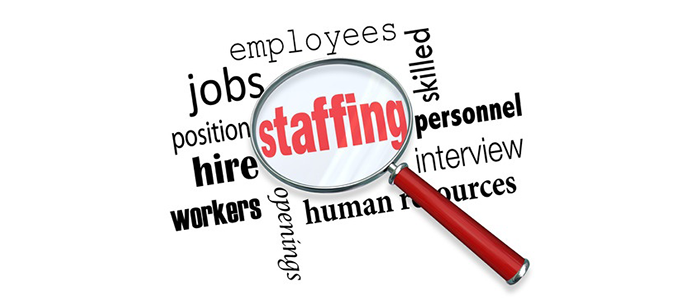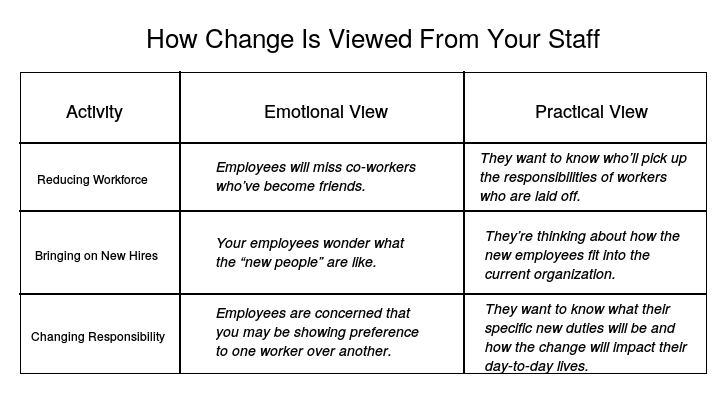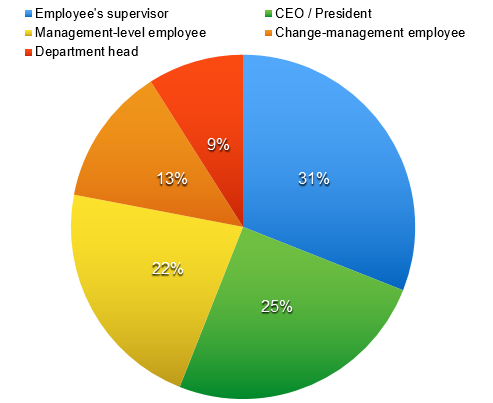
How to Do Staffing Changes Right
You know it’s time to make some changes to your workforce.
You’ve been thinking about it for a long time.
- Maybe you added new systems to your business that have made managing it more efficient. Now that the systems are up-and-running, it’s time to lay-off some employees because you’re over-staffed.
- Perhaps you’ve reorganized how you run your warehouse and manage the electrical components in it, and have to move people into new roles based on your updated operations model.
- Or you work for a growing firm and it’s time to add people to your team to fill new roles.
No matter the reason for your organizational change, you’re probably concerned about how these changes could impact the workflow — and the cash flow — of your electrical services business.
If you plan carefully, organizational changes — even large ones — won’t have a negative impact on your company. In fact, if done correctly, changes to your workforce could start paying off in increased business from day one.
Your organization is a family
You may wonder why a change at your firm can seem like such a big deal for your employees. It’s because most people view their workplace — and their co-workers — as a second home and family. They’ve built close, personal relationships with their co-workers. And it’s likely their “work family” has a way of doing things, hierarchy and pecking order that they’ve grown comfortable with. (This article from TINY News explains the business family dynamic in a fun and engaging way.)
Similar to family issues, concerns related to workplace change can be as much about emotional things as rationale or organizational ones. And you should be prepared to manage not just the practical — but also the emotional — aspects of the change management process.
Here’s how some common changes could be viewed by the workers at your firm both emotionally and practically:
- Reducing your workforce
- Emotionally: Employees will miss co-workers who’ve become friends.
- Practically: They want to know who’ll pick up the responsibilities of workers who are laid off.
- Bringing on new hires
- Emotionally: Your employees wonder what the “new people” are like.
- Practically: They’re thinking about how the new employees fit into the current organization.
- Changing responsibilities
- Emotionally: Employees are concerned that you may be showing preference to one worker over another.
- Practically: They want to know what their specific new duties will be and how the change will impact their day-to-day lives.
So what can you do to manage both the emotional and practical aspects of workplace change? Here’s how you can get started.
Put yourself in your employee’s shoes
According to a report in The Houston Chronicle, one of the first things you should do at the beginning of the change management process is understand how your employees will respond to it. Change could impact them in four different ways:
Mental stress: When many people face change, they experience stress. Fear of the unknown, lack of communication, and perceived injustices can all cause stress in your workforce. According to a report by the Centers for Disease Control, stress in the workplace can very significantly impact performance. Errors can increase as well as employee absenteeism, two things that can impact your bottom line when your business is undergoing change.
Family stress. The impact of workplace change doesn’t end at your company door. They can affect the home life of your employees, as well. Changes in schedules or job duties could cause difficulties with things like childcare responsibilities, sleep patterns and the need to do work at home. Disruptions in home life can impact employee performance almost more than any other factor.
Loss of loyalty. Some employees view a period of organizational change as an opportunity to “jump ship” and look for opportunities elsewhere. Those who remain with your company — whether by choice or because they could not find jobs elsewhere — may feel less loyal to you and your electrical business. A lack of loyalty could translate into lower motivation — the worst thing that could happen at a time when you most need your employees to step up and into new roles.
Increased time away from work. Employees who face change frequently fall into two camps: those who address it head-on and try to make the most of it and others who prefer to avoid it. Employees who like change can be a huge asset to your firm. But the “avoiders” will likely take more time off, go out for longer lunches and extend their breaks. Again, this form of lower employee productivity will cut into your bottom line at a time when you can least afford it.

Putting yourself into your employees’ shoes is an important first step toward managing change effectively.
The questions you should ask yourself
Finding it hard to understand your employees? Daptiv,a company experienced in organizational change management, suggests asking yourself questions like these to better understand how your workers will respond to change:
Will your employees be required to learn new skills based on their new role in your organization? How do those new skills apply to what the already know?
Why this is important: Learning new things is stressful for many people. Being sensitive to this will help facilitate change. Support your employees by taking time to relate the things they need to learn for their new job to the things they already know and do well.
Case study: John runs a mining business in New Mexico. He decided it would improve the efficiency of his mining operation if he could use his truckers to drive the fork lifts in his warehouse when they were not out doing pick-ups and deliveries.
The drivers did not feel confident about using this new equipment. John eased the transition by explaining that driving ability was the foundational skill for running the forklifts and learning the additional features would be a relatively simple add-on.
Will this organizational change increase or decrease the amount of work an employee is doing? Will this be a big change?
Why this is important: The word “relative” is key here. If you can find a way to minimize the size of the change to your employees, or finding ways to explain how their new world will compare to the old, will help them transition more smoothly into your new organizational structure.
Case study: Minnie manages a small business that rents lights, speakers and other electrical equipment to concert venues. During a crunch period, she asked employees to work some double shifts to get through the crisis.
Minnie was able to explain that she was limiting the extended shifts to the crisis period, which would last approximately two weeks. Her employees were happy to pitch-in, knowing that life would return to normal in a short time.
Why is this change happening?
Why this is important: Humans are naturally suspicious. If you can explain the rationale for change, people will feel more comfortable with it.
Case study: Bob’s electrical contracting firm is growing rapidly. When he decided to bring on some new employees, the gossip in his warehouse went into overdrive. People wondered how the new people would impact the business.
Bob used part of a staff meeting to explain why he was adding the new workers to his team. He shared growth projections for the business and a new organizational structure. Once his employees had a clear picture of why he was making the change and how it would impact them, they felt more comfortable and the gossip stopped.
What is the overall impact of the change?
Why this is important: Is the current change once-and-done, or is there more to come? Your employees will feel more comfortable if you can tell them that the change is finite and limited. Open-ended change can lead to employee insecurity. (If the change is an open-ended one, you still need to be honest and explain that to them.)
Case study: There have been a lot of consolidations in the emergency relief business. In order to stay competitive with other firms in Connecticut, a business in Hartford had to lay off several workers. Within a few weeks of the layoffs, three employees jumped ship and went to work for other emergency relief businesses.
The owner of the firm stopped the out-flow and kept other top employees from leaving by explaining that he did not plan any future layoffs. He was very specific and shared statistics and competitive information that helped his workers feel more secure in their jobs.
How will this impact families?
Why this is important: While employees view their co-workers as family, their “real” families are central to their lives. Organizational changes that keep them from doing things like picking up their kids from school or caring for aging parents will drive them away from “your” family. Have an open door policy with your workers that helps them feel comfortable discussing family issues with you. And make the time to help find solutions for those issues.
Case study: Minnie’s employees at the concert venue rental firm all have families and Minnie knew the double shifts would impact her employee’s family responsibilities. When she announced the double shifts, she made it clear that anyone could talk to her at any time about their family needs and she would do all she could to be flexible so they could care for their parents and children.
Is your company genuinely committed to its employees?
Why this is important: If it feels like you’re willing to put as much effort into organizational change as your employees, they’ll be in it with you for the long haul. And even though you want to minimize the impact on your bottom line, you should have some sort of realistic “financial cushion” in place to provide support to your employees.
Case study: John knew that when he asked the drivers at his mining company to take on additional responsibilities, he knew a period of transition was necessary. He added time for training — and some inefficiency — into his monthly projections. His employees appreciated that he gave them adequate — non-pressured — time to learn their new duties.
Once you understand your employee’s mindset and have a clear picture of how change will impact them, it’s time to start talking.
Communicate. Communicate.
And communicate again.
Communication is the most important part of the change management process.
According to the Change Management Best Practices Benchmarking Report, a study that involved 288 companies from 51 countries, most respondents felt that it’s important to communicate to employees about change as least once a week — or more.

The same study also showed companies get creative about how they communicate about change. This list could help you think about options that could be effective for your business.
| Brown bag lunches | Bulletin boards | Cafeteria postings | Communication trees |
| Booklets | Newsletters | Demonstrations | Meetings |
| Emails | Faxes | Focus groups | Question & answer |
| Memos | Intranet | Leaflets | One-on-ones |
| Posters | Presentations | Roadshows | Town halls |
| Training | Videos | Voicemails | Workshops |
While all of these methods can be effective in getting the message out, most study respondents felt that face-to-face communications are the best.
Another thing to consider is who should communicate these messages. The breakdown from the study could help you think about who should do it for your firm.
Most companies use a senior leader to make big organizational change announcements and leverage managers and supervisors to support those messages and explain them to workers in a more personal, one-to-one way.
Finally, based on all we covered in the previous sections, here are the specific things you must communicate about your organizational change in order for it to be a smooth one:
- The reason for the change
- What the workplace will be like after the change takes place
- What is changing, how it will change, and when it will change
- The expectation that change will happen and is not a choice
- Status updates
- The impact of the change on the day-to-day activities of the employee
- How change will impact job security
- Behaviors and activities expected from employees
- How to get help and answers to questions.
Finally
The most important thing you can to to ensure your organizational change will be a successful one that won’t cut into your bottom line is to always be honest. Honesty is critical and employees can always sniff out a lack of candor or completeness.
Honest, clear, continuing and well-thought out communications that focus on your employees and their concerns will get you from where your organization is today to where you want it to be in the future. It will add to — and not reduce — your bottom line.

 CALL OR TEXT NOW 800-597-9311
CALL OR TEXT NOW 800-597-9311

Leave a comment